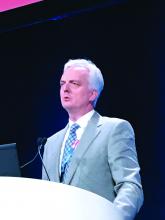NATIONAL HARBOR, MD. – In a head-to-head comparison, the ultrathin-strut Orsiro drug-eluting stent (DES) is demonstrating a growing advantage over the thin-strut Xience DES stent in stable patients undergoing coronary revascularization, according to a presentation at the 2020 CRT meeting.
“These results direct our attention to strut thickness and polymer composition as key attributes for stent design,” reported David E. Kandzari, MD, director of interventional cardiology at the Piedmont Heart Institute in Atlanta.
In the multinational BIOFLOW V trial, 1,334 patients were randomized in a two-to-one ratio to the Orsiro stent, which is composed of a bioabsorbable, sirolimus-eluting polymer, or to the Xience stent, which is composed of an everolimus-eluting durable polymer. Relative to the Xience device, which has thin struts of 81 microns in width, the struts of the Orsiro device, at 60 microns in width, are characterized as ultrathin.
In earlier published follow-up studies, the ultrathin device demonstrated a lower rate of target lesion (TL) failure at 1 year (5.9% vs. 9.2%; P = .032) and at 2 years (7.1% vs. 11.1%; P = .015), but the 3-year data are notable because they indicate that the relative advantage is continuing to grow, according to Dr. Kandzari.
At 3 years, with follow-up available for 94.8% and 94.2% of the Orsiro and Xience groups, respectively, the absolute relative difference in the primary endpoint of TL failure reached 5.4% (8.2% vs. 13.6%; P = .002) in favor of the Orsiro device.
For the components of the composite TL failure endpoint, which includes cardiovascular death, TL-related myocardial infarction, and TL revascularization, there were large relative advantages for every outcome except cardiovascular death, which did not differ between the Orsiro and Xience groups (1.1% vs. 1.2%, respectively; P = .1). Conversely, the TL-related MI (5.5% vs. 10.1%; P = .004) and ischemia-driven TL revascularization (3.4% vs. 6.9%; P = .008) rates were nearly cut in half in the Orsiro arm.
“The benefit appears to be bimodal in that there is a significant advantage in the periprocedural period [for the Orsiro device] and then a late advantage,” Dr. Kandzari reported.
Most TL-related MI in both groups, for example, occurred within the first 30 days of follow-up. Although there was a relative advantage for the Orsiro device in this early period (4.1% vs. 6.7%; P = .04), Dr. Kandzari indicated that the advantage between 30 days and 3 years was even more impressive (0.95% vs. 2.8%; P = .012).
Dr. Kandzari, showing a graph in which the line representing Orsiro device hugged the x axis as the line for the Xience device climbed, emphasized that the rate of target vessel MI at the end of follow-up was nearly three times greater for those randomized to the Xience device.
The patterns of ischemia-driven TL revascularization also diverged. In this case, the rates over the first 360 days were very similar for the two devices initially. At 1 year, the lower rate in the Orsiro device was not significantly different (2.0% vs. 2.3%; P = .72), but the lines began to separate at about 18 months. By the end of 3 years, the rate of ischemia-related TL revascularization was nearly 70% lower in the Orsiro arm (1.5% vs. 4.7%; P < .001).
The Orsiro device was also linked with a lower rate of definite or probable stent thrombosis when the two devices were compared from 30 days post implantation to 3 years of follow-up (0.1% vs. 1.2%; P = .018).
Noting that there are several features of the Orsiro device that might explain these results, including the width of the struts, the biodegradable polymer, and the type of anti-inflammatory coating, Dr. Kandzari said that it is difficult to determine which attributes account for the overall or the specific advantages observed for the Orsiro device in the BIOFLOW V trial.
However, he hypothesized that “there might be different time lines for different benefits” related to individual device characteristics. For example, the ultrathin struts might be important for the early relative advantages while the biodegradation of the strut might explain the reduced need for revascularization.
Overall, “there is an emerging evidence base consistent across clinical trials demonstrating a potential efficacy and safety difference in favor of ultrathin struts,” according to Dr. Kandzari.
The data are “remarkable,” according to James B. Hermiller, MD, an interventional cardiologist at the Heart Center of Indiana in Indianapolis. A panel member for the CRT late-breaking trial session where these data were presented, Dr. Hermiller was impressed by the very low rate of revascularization in the extended follow-up.
“We have all wanted to see a flattening of these event curves after a year,” Dr. Hermiller said. He indicated that the BIOFLOW V data represent a departure from the need for revascularization and other late events so commonly seen over lengthening follow-up with earlier generation devices.
SOURCE: Kandzari DE. CRT 2020, Late Breaking Trials session S300.


